If you’ve taken a MyHeritage DNA test or uploaded your DNA data to MyHeritage, then you will have received a list of your DNA Matches. The list shows people whose DNA matches yours, the percentage of DNA you share, and your possible relationship. DNA results can imply several possible relationships between you and a DNA Match, such as 3rd – 4th cousin, but now you’d like to understand how you are related to the match. Where do you go from here?
We’ve just released a new feature — the DNA Match Review page — to help you answer that question. The new page offers a plethora of detailed information about each of your DNA Matches. Your DNA Match details are now consolidated into one place with different sections that will help you discover how the match may be related to you. This can open the door to new connections and discoveries to advance your family history research.
Below we describe the Match Review page comprehensively. We recommend reading this in depth because it includes important information about exciting new features, some of which are available only on MyHeritage.
Accessing the Review Match Page
On the DNA Matches list, click the “Review match” button in the bottom right corner of any of your matches, as shown below.
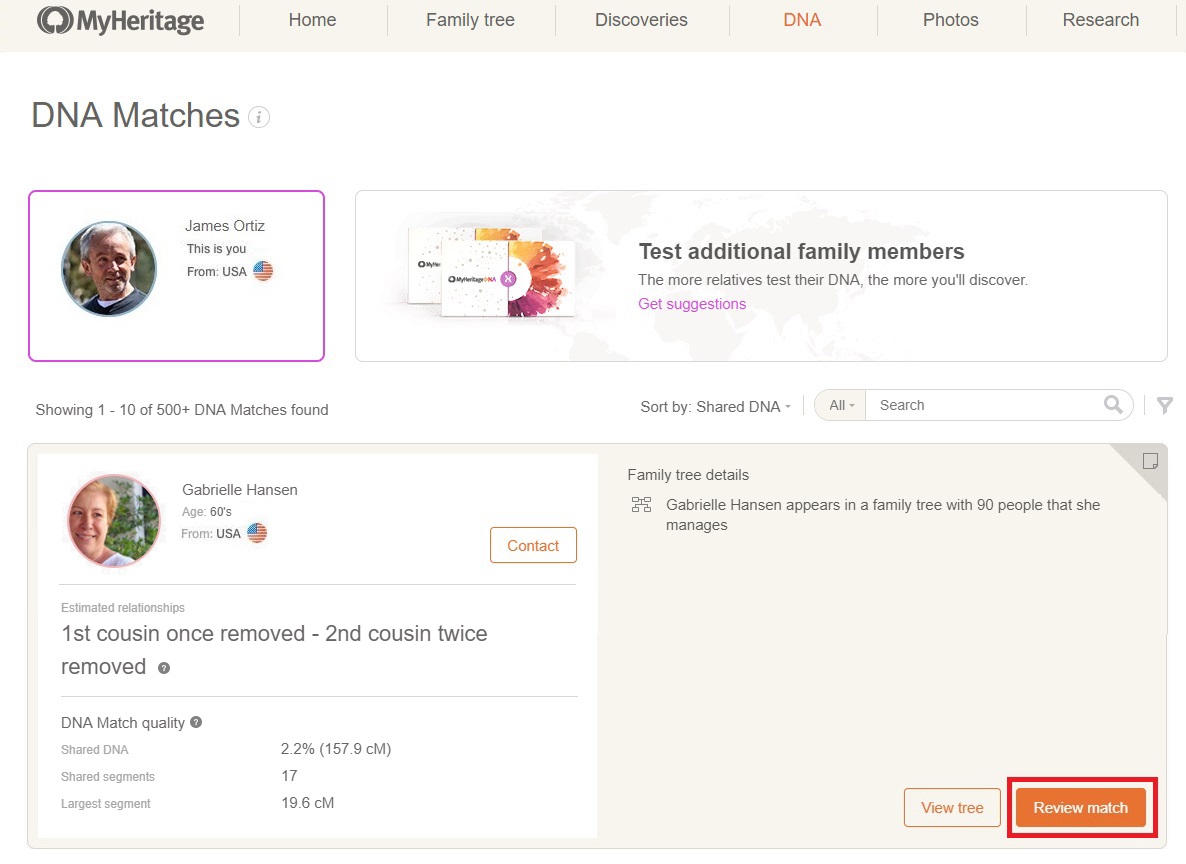
Accessing the new DNA Match Review page (click to zoom)
If you need a reminder on how to take full advantage of the features of the DNA Matches list, such as the powerful filters, see our previous blog post.
The DNA Match Review page shows all relevant data about the match, combining information from DNA and family trees. It is displayed in an easy to use side-by-side comparison. Here’s how the page looks, and below this image, we’ll breakdown these sections for you.

DNA Match Review page (click to zoom)
The Match Review page includes the following sections:
Smart Matches™
Smart Matching™ is a MyHeritage technology that matches people in your family tree with people in other family trees that users all over the world have created on MyHeritage.
The presence of Smart Matches increases the confidence of DNA Matches — If you share a percentage of DNA with someone, and your trees also have Smart Matches, it increases the likelihood that you are related and makes it easier for you to understand how you are related. You can contact the match and learn from each other about your shared common relatives.

Smart Matches™ section (click to zoom)
When a DNA Match is correct, i.e. is not a false positive, it means that you and the match have a common ancestor, from which both of you inherited some DNA. The DNA Match is found by MyHeritage if both of you inherited the same segments of DNA from that ancestor. If you have Smart Matches with the family tree of your DNA Match, they may include your common ancestor, or at the least help point you in the direction of that ancestor.
We’ve found that in many cases, when DNA brings two relatives together, neither of them knows about the other and it is rare for their family trees to overlap. That’s why in most of the DNA Matches you’ll review, there won’t be a Smart Matches section. When it does exist, you should rejoice as you will likely be able to find out exactly how you are related.
Ancestral Surnames
Ancestral surnames are the surnames of your direct ancestors (or the surnames of the direct ancestors of your DNA Match), which are retrieved from your family trees on MyHeritage. In DNA context, ancestral surnames are very important because every person is an aggregation of DNA segments from his or her ancestors. Therefore, the ancestral surnames indicate the families from which people have inherited their DNA, assuming their family trees are correct and faithfully depict their biological roots.
On MyHeritage, most DNA customers have family trees, which is very fortunate as it allows us to retrieve ancestral surnames and compare them for most DNA Matches.
If you and a DNA Match have shared ancestral surnames, this section will show the ancestral surnames you have in common – those surnames that appear in both your family trees, going back 10 generations.
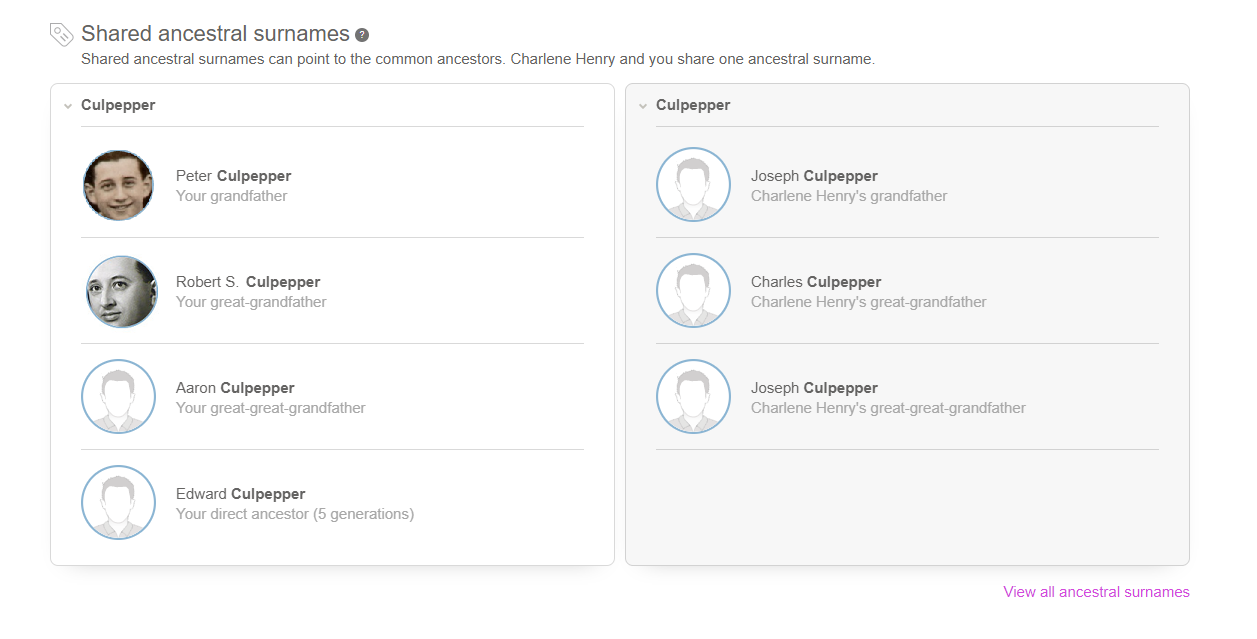
Shared Ancestral Surnames section (click to zoom)
This section can be extremely useful in determining which common ancestor you and the match share, helping you identify a potential common ancestor. Be careful though if the ancestral surname is very common, like Miller or Smith, because that is very likely not the same family. However, if the ancestral surname that you and your match share is extremely rare, such as Dankworth or Culpepper, you’re certainly on the cusp of understanding how you are related.
Click on the button “View all ancestral surnames” in the bottom right corner of this section, to see a new window with an alphabetized list of all the ancestral surnames in both your family tree and your DNA Match’s family tree. In this new window, you will be able to scroll through all ancestral surnames, and the surnames you share will be highlighted in purple.
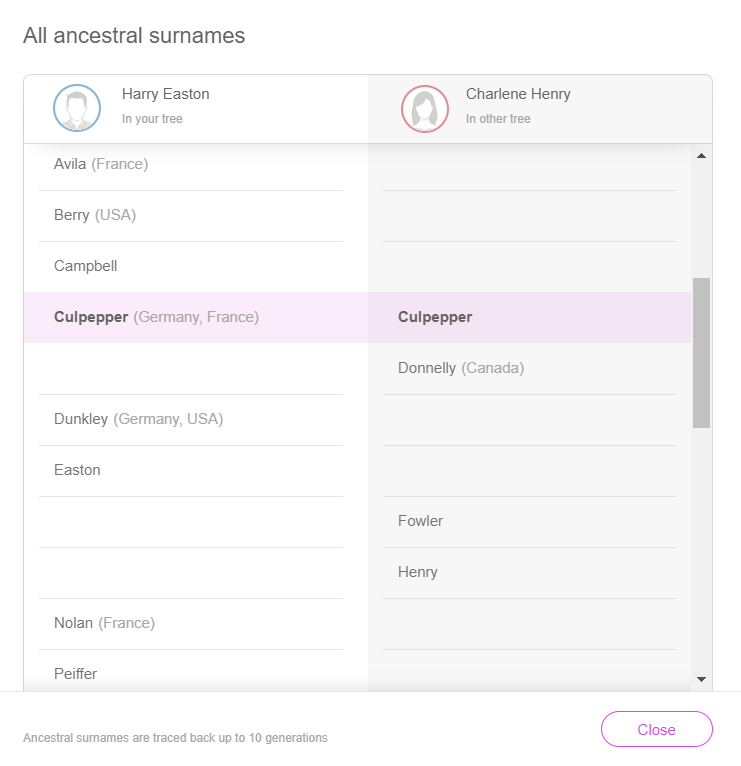
Viewing a list of all ancestral surnames (click to zoom)
Don’t have any shared ancestral surnames? Then we will still show you the ancestral surnames in both your family tree and the match’s family tree. This could be helpful if one of their surnames is similar to yours (though with a different spelling), or perhaps a surname will ring a bell and remind you of a relative not yet listed in your tree.
For example, you may have ancestors with the last name MacQuoid but you don’t know exactly where they connect in your tree, so you’ve never added them. After reviewing a DNA Match’s ancestral surnames, you might notice they have the surname MacQuoid in their tree, and you can begin putting together the puzzle of how you are related.
Next to each ancestral surname, we also list associated countries where vital events (birth, marriage, death, burial, etc.) occurred for the ancestors with that surname. This will be useful when trying to understand the possible relationship you might have with your DNA Match. For example, if you both share an ancestral surname from the same country, it can increase the strength of the match. You might not get excited about sharing the ancestral surname of Levine, but if both of you have Levine from Hungary, that could be more interesting. In addition, if you don’t have a shared surname, but you do share ancestors from the same countries, it could mean that you both share roots in the same region.
The list of ancestral surnames and their countries, even beyond the context of DNA, is very handy. We recommend for genealogists to copy the list of ancestral surnames and use it when they email other genealogists since the list serves as a convenient way of expressing one’s research interests. Some genealogists even use the ancestral surnames list as their email signature!
Shared DNA Matches
Shared DNA Matches are people who share DNA with both you and your DNA Match, meaning both of you have the same person in your list of DNA Matches. This is another way of increasing the confidence in your DNA Match and helps you learn which side of the family your DNA Match is on.
MyHeritage has a unique way of showing Shared DNA Matches. Unlike other testing services, we display – in one chart – how both you and your DNA Match are genetically related to the same person.

Shared DNA Matches section (click to zoom)
In this section, the name of each Shared DNA Match is clickable and allows you to go to the DNA Match Review page for that specific match.
If you and your DNA Match have many Shared DNA Matches, you can click on the button “Show more DNA Matches” in the bottom right corner of the section to review all of your Shared DNA Matches.
The Shared DNA Matches page helps you cluster our DNA Matches. Each cluster may indicate matches having the same common ancestor (sometimes there may be several different ancestors). You can collaborate with your matches to try to determine who that common ancestor is.
In time, you will learn to appreciate the power of the Shared DNA Matches page. For example, if you review a match and spot your paternal uncle in the list of shared matches, that is a good indication that the match is paternal for you. Testing more of your relatives will help you get more value from the Shared DNA Matches page, as it will help you determine the path to the common ancestor for many of your matches.
Pedigree Charts
Pedigree Charts show the main individual and their direct line of ancestors, i.e., parents, grandparents, great-grandparents, etc. These charts are especially helpful when looking for common ancestors and for identifying common names, which can provide an idea of how you are related.
The Pedigree Chart section shows your match’s direct ancestors in one tab and shows your own pedigree chart in an adjacent tab. Viewing the Pedigree Chart of your match’s family tree in this way makes it easy to check where your trees may overlap, and see if you spot anything familiar.

Pedigree Charts section (click to zoom)
The Pedigree Chart is condensed to show a lot of information in little space.
To view the full tree, click “View full tree” at the bottom right corner.
Women appear in the Pedigree Chart with their maiden names. To see more information about any person, hover the mouse over the card. A callout will open, as shown below, adding more information, such as birthplace and death place. It will also provide you with handy links to view the family tree around that person, visit the profile or research that person in MyHeritage’s huge collection of 8.1 billion historical records.
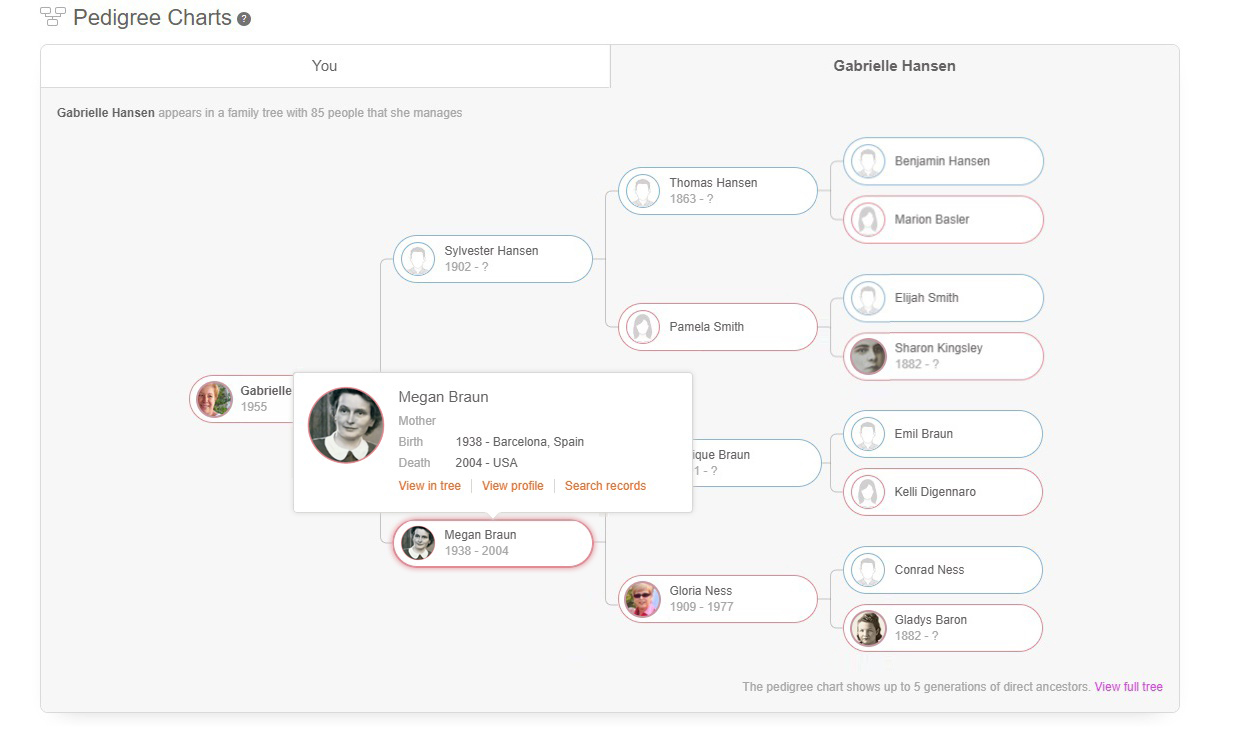
Person callout in Pedigree Chart (click to zoom)
If you are using MyHeritage DNA and still don’t have a family tree on MyHeritage, please build one now. It is very helpful for making sense of your DNA Matches and will also be helpful for other users whose DNA matches your own.
Whenever viewing the family tree of another person, living ancestors will be privatized.
Shared Ethnicities
For every DNA test taken on MyHeritage, or uploaded to MyHeritage, we calculate an Ethnicity Estimate, which finds ethnic origins. MyHeritage offers a breakdown of 42 different ethnic regions – more than any other major commercial DNA testing company.
The Shared Ethnicities section compares the Ethnicity Estimate of your DNA Match to your own to find similarities. This interesting section is visual and only displayed on MyHeritage this way. You will see the exact percentage break down of your ethnicities side-by-side with your DNA Match’s ethnicities, and those you share will be highlighted in purple.
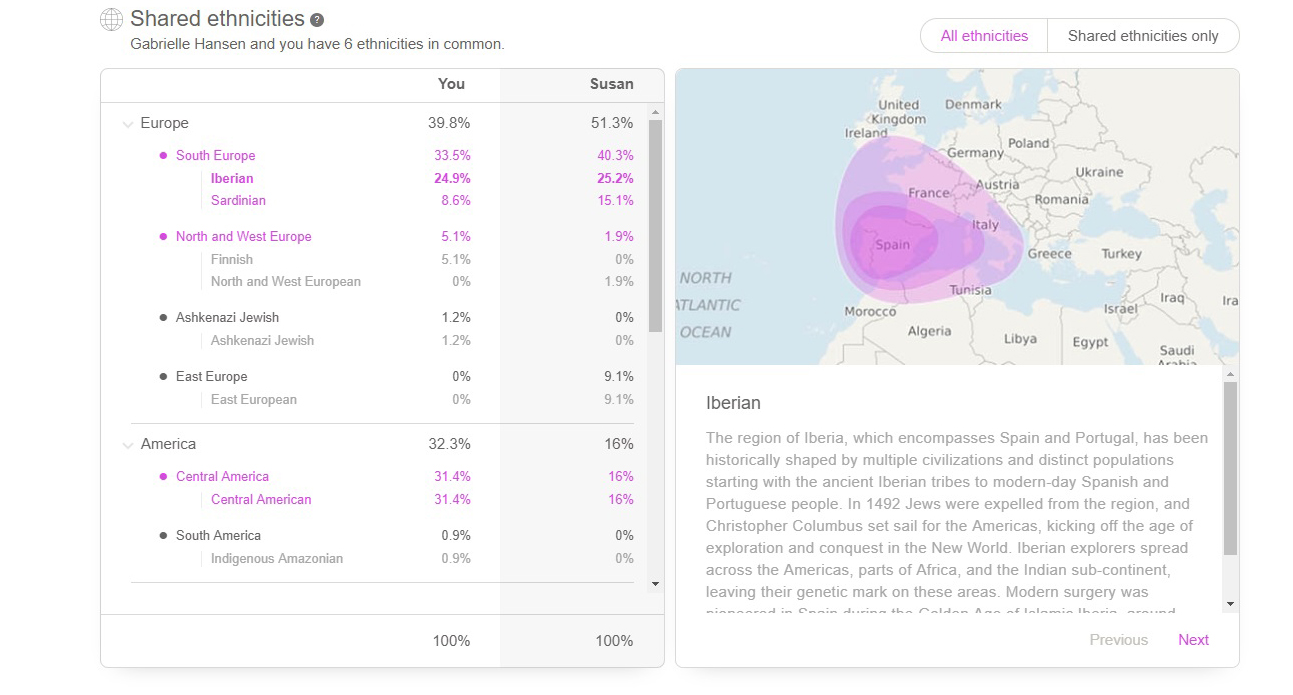
Shared Ethnicities section (click to zoom)
The Shared Ethnicities section can be useful for indicating the regions where you and your DNA Match may have common ancestral origins. Be aware though that you might share an ethnicity with a DNA Match, but not because you inherited it from the common ancestor that you share. Each of you may have gotten that ethnicity from other ancestors that you do not share.
You can use a toggle on the top right corner to show only shared ethnicities or all ethnicities. Click any ethnicity for more information about it.
Next steps
We’re not done with the Review Match page yet! Additional features are on the way to make the Review Match page even more informative and useful, such as the commonly requested Chromosome Browser, so keep an eye out for them.
Cost
For MyHeritage DNA customers, some sections on the Review Match page require a family site subscription to view them in their entirety. Users with a Premium, Premium Plus, or Complete subscription will have full access to all sections on the Review Match page, while Basic users will have a partial view of some sections.
Note: Some features listed above may not be shown for each of your DNA Matches if not relevant for that match. For example, if you match with someone who doesn’t have a family tree, then for that match you will not see tree components such as the Pedigree Chart, ancestral surnames and Smart Matches.
Conclusion
Take advantage of our new DNA Match Review page and delve into your DNA Matches. Matches previously overlooked can now be explored for new possible family connections. Instead of piecing together the puzzle yourself from scratch, these new tools will help you better understand how you are related to your matches.
Not in on the DNA action yet? Order your MyHeritage DNA kit today or, if you’ve already had your DNA tested by another company, upload your DNA data to MyHeritage and receive a comprehensive DNA Ethnicity Analysis and DNA Matching for free.
Enjoy!
MyHeritage Team
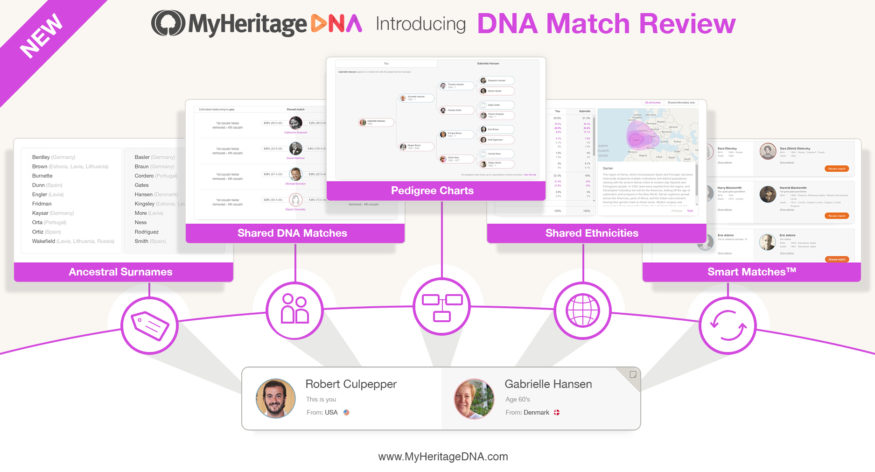
Jason Lee
August 22, 2017
Where’s the chromosome browser?